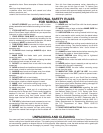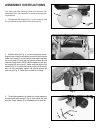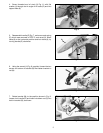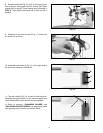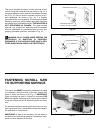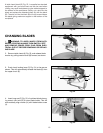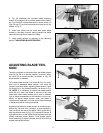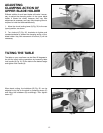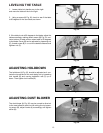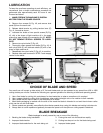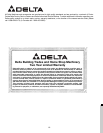3
ADDITIONAL SAFETY RULES
FOR SCROLL SAWS
1. DO NOT OPERATE your scroll saw until it is com-
pletely assembled and installed according to the instruc-
tions.
2. IF YOU ARE NOT thoroughly familiar with the oper-
ation of Scroll Saws, obtain advice from your supervisor,
instructor or other qualified person.
3. YOUR SCROLL SAW MUST be securely fastened
to a stand or workbench. If there is any tendency for the
stand or workbench to move during operation, the stand
or workbench MUST be fastened to the floor.
4. THIS SCROLL SAW is intended for indoor use only.
5. MAKE SURE blade is properly tensioned before
operating saw.
6. TO AVOID blade breakage ALWAYS adjust blade
tension correctly.
7. MAKE SURE the blade teeth point downward
toward the table.
8. NEVER turn the saw "ON" before clearing the table
of all objects (tools, scraps of wood, etc.).
9. DO NOT cut material that is too small to be safely
supported.
10. AVOID awkward hand positions where a sudden slip
could cause a hand to move into the blade.
11. ALWAYS keep hands and fingers away from blade.
12. ALWAYS adjust holddown foot for each new
operation.
13. DO NOT USE dull or bent blades.
14. DO NOT attempt to saw material that does not have
a flat surface, unless a suitable support is used.
15. MAKE "relief" cuts before cutting long curves
16. NEVER attempt to cut a curve that is too tight for
the blade being used.
17. WHEN backing a blade out of a workpiece, the
blade may bind in the saw kerf. This is usually caused by
sawdust in the kerf. If this happens, turn "OFF" the
switch and remove plug from power source outlet.
Wedge open the kerf and back blade out of the work-
piece.
18. THE USE of attachments and accessories not rec-
ommended by Delta may result in the risk of injuries.
19. ALWAYS hold the work firmly against the table.
20. DO NOT feed the material too fast while cutting.
Only feed the material fast enough so that the blade will
cut.
21. NEVER start the Scroll Saw with the stock pressed
against the blade.
22. WHEN cutting a large workpiece MAKE SURE the
material is supported at table height.
23. USE CAUTION when cutting material which is irreg-
ular in cross section which could pinch the blade before
the cut is completed. A piece of moulding for example
must lay flat on the table and not be permitted to rock
while being cut.
24. USE CAUTION when cutting round material such as
dowel rods or tubing. They have a tendency to roll while
being cut causing the blade to "bite." Use a V-block to
control the piece.
25. ALWAYS release blade tension before removing the
blade from the upper or lower blade holders.
26. MAKE CERTAIN table tilting lock is tightened
before starting the machine.
27. NEVER reach under the table while the machine is
running.
28. NEVER perform layout, assembly or set-up work on
the table while the saw is operating.
29. ALWAYS STOP the saw before removing scrap
pieces from the table.
30. WHEN THE TOOL IS NOT IN USE, the switch
should be locked in the “OFF” position to prevent unau-
thorized use.
31. SHOULD any part of your Scroll Saw be missing,
damaged or fail in any way, or any electrical component
fail to perform properly, shut off switch and remove plug
from power supply outlet. Replace missing, damaged or
failed parts before resuming operation.
32. ADDITIONAL INFORMATION regarding the safe
and proper operation of this product is available from
the National Safety Council, 1121 Spring Lake Drive,
Itasca, IL 60143-3201, in the Accident Prevention
Manual for Industrial Operations and also in the Safety
Data Sheets provided by the NSC. Please also refer to
the American National Standards Institute ANSI 01.1
Safety Requirements for Woodworking Machinery and
the U.S. Department of Labor OSHA 1910.213
Regulations.
33. SAVE THESE INSTRUCTIONS. Refer to them often
and use them to instruct others.
UNPACKING AND CLEANING
Your new scroll saw is shipped complete in one carton; carefully unpack the saw and all loose items. Remove the pro-
tective coating from the saw table surface. This coating may be removed with a soft cloth moistened with kerosene (do
not use acetone, gasoline or lacquer thinner for this purpose). After cleaning, cover the table surface with a good qual-
ity paste wax. Buff out the wax thoroughly to prevent it from rubbing into your workpieces.
reproductive harm. Some examples of these chemicals
are:
·lead from lead-based paints,
·crystalline silica from bricks and cement and other
masonry products, and
·arsenic and chromium from chemically-treated lumber.
Your risk from these exposures varies, depending on
how often you do this type of work. To reduce your
exposure to these chemicals: work in a well ventilated
area, and work with approved safety equipment, such as
those dust masks that are specially designed to filter out
microscopic particles.





